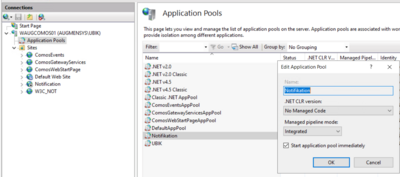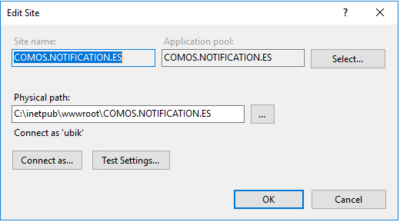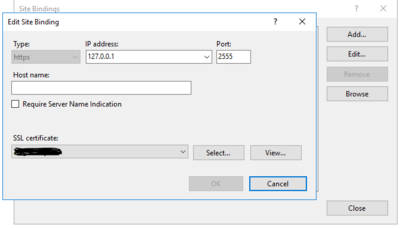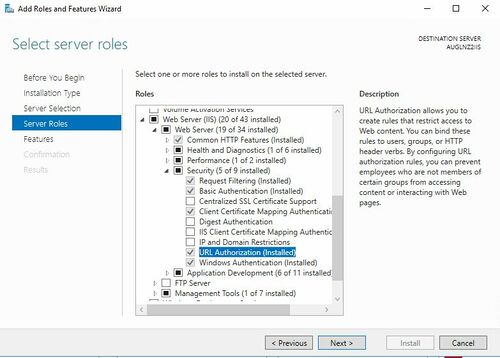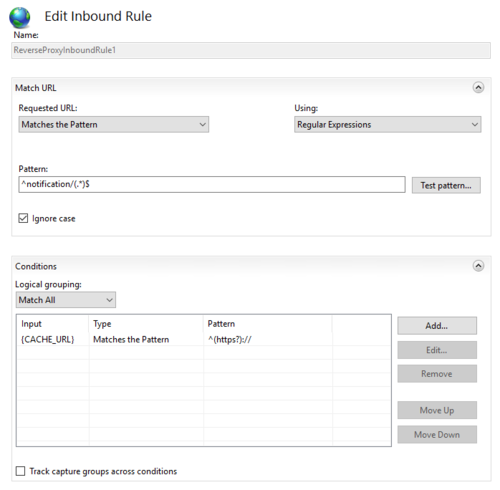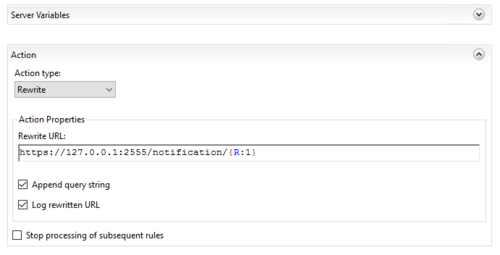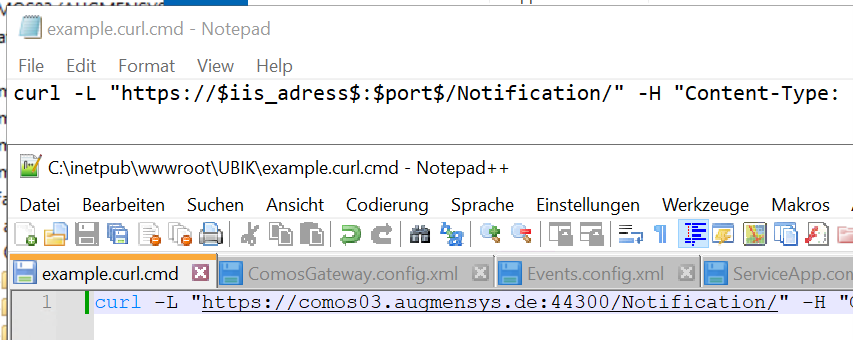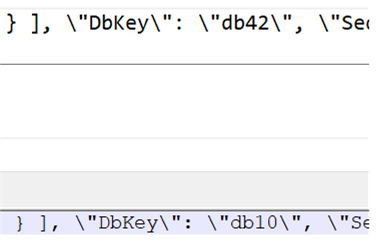Difference between revisions of "Configure EventNotification Endpoint and Enterprise Service for CUI"
(→Direct Access) |
|||
| (92 intermediate revisions by 3 users not shown) | |||
| Line 1: | Line 1: | ||
| − | EventNotification Endpoint is a middleware which is responsible | + | EventNotification Endpoint is a middleware which is responsible for receiving incoming COMOS event notifications, queuing them internally and forwarding them to the {{UBIK}} Enterprise Service for further processing. |
This page describes how to setup the system. | This page describes how to setup the system. | ||
= Overview = | = Overview = | ||
| − | * Make sure [[HowTo:Install_UBIK_Enterprise_Service|Enterprise Service]] and USAM are installed on IIS Server. | + | * Make sure the [[HowTo:Install_UBIK_Enterprise_Service|Enterprise Service]] and the [[HowTo:Install_UBIK_Web_Service#UBIK.C2.AE_Authentication_Web_Service_USAM.svc|USAM]] are installed on the IIS Server. |
| − | * Install Notification Endpoint | + | * Install the Notification Endpoint Webservice on the IIS Server |
| − | * Configure mandatory settings for Notification Endpoint Webservice | + | * Configure all mandatory settings for the Notification Endpoint Webservice |
| − | * Configure Notification Endpoint | + | * Configure the Notification Endpoint Webservice URL in COMOS and enable notifications |
| + | * Make sure all files are accessible | ||
| + | |||
= Install Notification Endpoint = | = Install Notification Endpoint = | ||
| − | * Download Notification | + | * Download the Notification Endpoint Webservice from the release portal. |
| − | * Deploy the Notification | + | * Deploy the Notification Endpoint Webservice to the designated web app folder on the IIS Server (web app folder needs to be created if necessary) |
| − | + | ** IIS Manager setting check: see [[Configure_EventNotification_Endpoint_and_Enterprise_Service_for_CUI#IIS_Manager|IIS Manager]] | |
| + | * Make sure COMOS is configured to send notifications. | ||
| + | |||
| + | |||
| + | == IIS Manager == | ||
| + | Please first create an Application Pool for Notifications in IIS. | ||
| + | You can Name it like you want to, but please make sure that the .NET CLR version: "No Managed Code" | ||
| + | |||
| + | |||
| + | [[File:App_pool.png|400px]] | ||
| + | |||
| + | [[Category:Version 4.3|Configure EventNotification Endpoint and Enterprise Service for CUI]] | ||
| + | |||
| + | = Direct Access = | ||
| + | * Add a new website under the "Sites" folder in IIS Manager. | ||
| + | * Connect the new site to the corresponding physical folder via the website's "basic settings". <br/> [[Image:WebsiteConfIIS.PNG|400px]] | ||
| + | ** "Site Name", "Application pool" and "Physical path" should be adapted by your setting, here are only example | ||
| + | * Configure a "Binding" for the website.<br/>[[Image:BindingIISConf.PNG|400px]] | ||
| + | ** The URL can be used as a direct access target, | ||
| + | ** '''or used as an internal target for [[Configure_EventNotification_Endpoint_and_Enterprise_Service_for_CUI#URL_redirection|URL redirection]].''' | ||
| + | |||
| + | Please make sure your configureed Port is not blocked by ohter Processes or the Firewall. | ||
| + | |||
| + | [[Category:Version 4.3|Configure EventNotification Endpoint and Enterprise Service for CUI]] | ||
| + | |||
| + | =URL redirection= | ||
| + | * Install URL redirect feature by using "Server Manager", to "Add Roles and Features Wizard": | ||
| + | [[Image:Urlredirect.JPG|500px]] | ||
| + | * Click on the Web Site, which will be exposed to the outside | ||
| + | * Open "URL Rewrite" at "....Home" | ||
| + | * Add rule(s) as 'Inbound Rule' like the following: | ||
| + | [[Image:InboundRules.PNG|500px]] | ||
| + | [[Image:InboundRules2.PNG|500px]] | ||
| + | |||
| + | '''Rewrite URL is defined base on direct access''' | ||
| + | |||
| − | |||
= Notification Endpoint= | = Notification Endpoint= | ||
Adapt “Your/EventNotificationEndpoint/Folder/Configuration/config.json” file, configure at least the mandatory settings: | Adapt “Your/EventNotificationEndpoint/Folder/Configuration/config.json” file, configure at least the mandatory settings: | ||
| + | * "USAMUrl": The URL of the USAM Service | ||
| + | * "QueuePath": The folder containing all files, which will be sent to Enterprise Service for processing. After having been processed by ES, the corresponding files will be deleted. | ||
| + | * "InComingLogPath": All received COMOS notifications will be stored here | ||
| + | * "ProcessUrl": The URL of the Enterprise Service web interface | ||
| + | <br/> | ||
| + | Optional settings: | ||
| + | * "LogPath": Path to your log files folder | ||
| + | * "DeleteLogAfter": Maximum age (in days) to keep log files for | ||
| + | * "DBkeys": Json string array containing the white list of COMOS DBkeys (empty or delete for receiving all DBkeys) | ||
| − | + | <source lang = "yaml"> | |
| − | + | { | |
| − | + | "USAMUrl": "https://comos03.augmensys.de/UBIK/USAM/USAM.svc", | |
| − | + | "ProcessUrl": "http://localhost:9000/api/UbikContent/Content/", | |
| + | "InComingLogPath": "C:\\Temp\\JSON", | ||
| + | "QueuePath": "C:\\Temp\\QUEUE", | ||
| + | "LogPath": "C:\\Temp\\LOGS", | ||
| + | "DeleteLogAfter": 10, | ||
| + | "DBKeys": ["db10"] | ||
| + | } | ||
| + | </source> | ||
| + | [[Category:Version 4.3|Configure EventNotification Endpoint and Enterprise Service for CUI]] | ||
= Enterprise Service= | = Enterprise Service= | ||
| − | * Go to UBIK.EnterpriseService folder, | + | * Go to the UBIK.EnterpriseService folder, |
| − | + | * Copy and paste UBIK.Interface.CUI.dll to the “Injection” folder (create it if it does not exist). | |
| − | + | * Open UBIK.EnterpriseService.exe.config, find the “appSettings” section, configure all necessary information, and add the "ContentControllerConfigPath" setting to the end: | |
| − | + | <source lang = "xml"> | |
| − | + | <appSettings> | |
| − | + | <!-- System.Diagnostics.ProcessWindowStyle: Normal = 0, Hidden = 1, Minimized = 2, Maximized = 3 --> | |
| − | < | + | <add key="ConsoleRunMode" value="1" /> |
| − | '''Make sure ContentController.json | + | <!-- Nothing = 0, Mark = 1, Delete = 2 --> |
| − | * | + | <add key="CommandFileAction" value="0" /> |
| + | <add key="ClearWatchFolders" value="0" /> | ||
| + | <!-- Path to json file. Pointing to EnterpriseServicePluginExecutionConfigHolder --> | ||
| + | <add key="PluginExecutionConfigPath" value="" /> | ||
| + | <add key="ClientSettingsProvider.ServiceUri" value="" /> | ||
| + | <!--TEST IF ONLINE USING BROWSER // GET http://localhost:9000/api/basicenterpriseservice/getuptimeinfo--> | ||
| + | <!-- switch on WebInterface: 1, switch off WebInterface : 0 --> | ||
| + | <add key="ExecuteWebInterface" value="1" /> | ||
| + | <add key="ExecuteTaskByJsonFile" value="0" /> | ||
| + | <!-- Notification Endpoint config ProcessUrl --> | ||
| + | <add key="WebInterfacePort" value="9000" /> | ||
| + | <add key="WebInterfaceHost" value="http://localhost" /> | ||
| + | <!-- Add this to the ES config file --> | ||
| + | <add key="ContentControllerConfigPath" value="your\setting\path\ContentController.json" /> | ||
| + | </appSettings> | ||
| + | </source> | ||
| + | '''Make sure ContentController.json exists.''' | ||
| + | * Create or adapt ContentController.json according to your database connection: | ||
| + | <source lang = "yaml"> | ||
{ | { | ||
| − | + | "SqlConnectionDefinition": | |
| + | { | ||
"SSPI": false (or true, based on your DB setting), | "SSPI": false (or true, based on your DB setting), | ||
"SQLUser": "username", | "SQLUser": "username", | ||
| Line 41: | Line 113: | ||
"SQLServer": "your SQL Server", | "SQLServer": "your SQL Server", | ||
"SQLInitialCatalog": "DB name" | "SQLInitialCatalog": "DB name" | ||
| − | + | } | |
} | } | ||
| + | </source> | ||
| + | * Example: | ||
| + | ** "SQLUser": "aaa" | ||
| + | ** "SQLPassoword": "bbb" | ||
| + | ** "SQLServer": "(localdb)\ProjectModels" | ||
| + | ** "SQLInitialCatalog": "TEMPLATE.LOCAL" | ||
| + | '''Pay attention on JSON escape with ' \" ', ' \\ '''' | ||
| + | |||
| + | |||
| + | To Create a Service on your Server use the Command SC, to thest if the Server is configured Correctly open a cmd propmt as Admin and Type "SC" and you should get the help how to use as answer. | ||
| + | |||
| + | Depending if youre direktly on the Server or not you may have to use the Servername or not: | ||
| + | |||
| + | To Create: | ||
| + | <source lang = "PowerShell"> | ||
| + | sc #servername# create "UBIK_ES_NOTIF" binPath= "#your installation folder#\UBIK.EnterpriseService.exe" start= auto DisplayName= "UBIK_ES_NOTIF" | ||
| + | </source> | ||
| + | To Name: | ||
| + | <source lang = "PowerShell"> | ||
| + | sc #servername# description "UBIK_ES_NOTIF" "UBIK_ES_NOTIF" | ||
| + | </source> | ||
| + | To Start: | ||
| + | <source lang = "PowerShell"> | ||
| + | sc #servername# start "UBIK_ES_NOTIF" | ||
| + | </source> | ||
| + | |||
| + | if you want to rebuild after update you may use es first | ||
| + | |||
| + | To Delete: | ||
| + | <source lang = "PowerShell"> | ||
| + | sc #servername# delete "UBIK_ES_NOTIF" | ||
| + | </source> | ||
| + | |||
| + | |||
| + | After starting IIS and UBIK Enterprise server you can test if its working with calling the webpage, http://localhost:9000/api/basicenterpriseservice/getuptimeinfo on the Server, the answer will be a Json file with a short Text like this | ||
| + | This XML file does not appear to have any style information associated with it. The document tree is shown below. | ||
| + | <string xmlns="http://schemas.microsoft.com/2003/10/Serialization/">BasicEnterpriseServiceController is online at 11.04.2025 12:39:40</string> | ||
| + | |||
| + | With the UBIK.Notification.Endpoint there is a “example.curl.cmd” delivered for Testing the Notification Endpoint. | ||
| + | If you open the file for editing at the start you have to insert your Servername and Port: | ||
| + | |||
| + | |||
| + | [[File:CURL_01.png]] | ||
| + | |||
| + | And at the end of the file you should find the DbKey you have to exchange it to your DBkey form setup. | ||
| + | |||
| + | [[File:CURL_02.png]] | ||
| + | |||
| + | After saving and running the command File you should get a Log in the Configured Log Folder, that should look mostly like this. | ||
| + | |||
| + | [[File:CURL_03.png]] | ||
| + | |||
| + | Now you Know that the Notification Endpoint is working with your Configuration. | ||
| + | |||
| + | |||
==See also== | ==See also== | ||
<!-- DO NOT MODIFY THE NAME OF THIS SECTION, BUT REMOVE IT IF NOT REQUIRED --> | <!-- DO NOT MODIFY THE NAME OF THIS SECTION, BUT REMOVE IT IF NOT REQUIRED --> | ||
| + | * [[HowTo:Install_UBIK_Web_Service#UBIK.C2.AE_Authentication_Web_Service_USAM.svc]] | ||
| + | * [[HowTo:Install_UBIK_Enterprise_Service]] | ||
| + | |||
| + | [[Category:Version 4.3|Configure EventNotification Endpoint and Enterprise Service for CUI]] | ||
Latest revision as of 12:55, 15 October 2025
EventNotification Endpoint is a middleware which is responsible for receiving incoming COMOS event notifications, queuing them internally and forwarding them to the UBIK® Enterprise Service for further processing. This page describes how to setup the system.
Contents
Overview
- Make sure the Enterprise Service and the USAM are installed on the IIS Server.
- Install the Notification Endpoint Webservice on the IIS Server
- Configure all mandatory settings for the Notification Endpoint Webservice
- Configure the Notification Endpoint Webservice URL in COMOS and enable notifications
- Make sure all files are accessible
Install Notification Endpoint
- Download the Notification Endpoint Webservice from the release portal.
- Deploy the Notification Endpoint Webservice to the designated web app folder on the IIS Server (web app folder needs to be created if necessary)
- IIS Manager setting check: see IIS Manager
- Make sure COMOS is configured to send notifications.
IIS Manager
Please first create an Application Pool for Notifications in IIS. You can Name it like you want to, but please make sure that the .NET CLR version: "No Managed Code"
Direct Access
- Add a new website under the "Sites" folder in IIS Manager.
- Connect the new site to the corresponding physical folder via the website's "basic settings".
- "Site Name", "Application pool" and "Physical path" should be adapted by your setting, here are only example
- Configure a "Binding" for the website.
- The URL can be used as a direct access target,
- or used as an internal target for URL redirection.
Please make sure your configureed Port is not blocked by ohter Processes or the Firewall.
URL redirection
- Install URL redirect feature by using "Server Manager", to "Add Roles and Features Wizard":
- Click on the Web Site, which will be exposed to the outside
- Open "URL Rewrite" at "....Home"
- Add rule(s) as 'Inbound Rule' like the following:
Rewrite URL is defined base on direct access
Notification Endpoint
Adapt “Your/EventNotificationEndpoint/Folder/Configuration/config.json” file, configure at least the mandatory settings:
- "USAMUrl": The URL of the USAM Service
- "QueuePath": The folder containing all files, which will be sent to Enterprise Service for processing. After having been processed by ES, the corresponding files will be deleted.
- "InComingLogPath": All received COMOS notifications will be stored here
- "ProcessUrl": The URL of the Enterprise Service web interface
Optional settings:
- "LogPath": Path to your log files folder
- "DeleteLogAfter": Maximum age (in days) to keep log files for
- "DBkeys": Json string array containing the white list of COMOS DBkeys (empty or delete for receiving all DBkeys)
"USAMUrl": "https://comos03.augmensys.de/UBIK/USAM/USAM.svc",
"ProcessUrl": "http://localhost:9000/api/UbikContent/Content/",
"InComingLogPath": "C:\\Temp\\JSON",
"QueuePath": "C:\\Temp\\QUEUE",
"LogPath": "C:\\Temp\\LOGS",
"DeleteLogAfter": 10,
"DBKeys": ["db10"]
}
Enterprise Service
- Go to the UBIK.EnterpriseService folder,
- Copy and paste UBIK.Interface.CUI.dll to the “Injection” folder (create it if it does not exist).
- Open UBIK.EnterpriseService.exe.config, find the “appSettings” section, configure all necessary information, and add the "ContentControllerConfigPath" setting to the end:
<!-- System.Diagnostics.ProcessWindowStyle: Normal = 0, Hidden = 1, Minimized = 2, Maximized = 3 -->
<add key="ConsoleRunMode" value="1" />
<!-- Nothing = 0, Mark = 1, Delete = 2 -->
<add key="CommandFileAction" value="0" />
<add key="ClearWatchFolders" value="0" />
<!-- Path to json file. Pointing to EnterpriseServicePluginExecutionConfigHolder -->
<add key="PluginExecutionConfigPath" value="" />
<add key="ClientSettingsProvider.ServiceUri" value="" />
<!--TEST IF ONLINE USING BROWSER // GET http://localhost:9000/api/basicenterpriseservice/getuptimeinfo-->
<!-- switch on WebInterface: 1, switch off WebInterface : 0 -->
<add key="ExecuteWebInterface" value="1" />
<add key="ExecuteTaskByJsonFile" value="0" />
<!-- Notification Endpoint config ProcessUrl -->
<add key="WebInterfacePort" value="9000" />
<add key="WebInterfaceHost" value="http://localhost" />
<!-- Add this to the ES config file -->
<add key="ContentControllerConfigPath" value="your\setting\path\ContentController.json" />
</appSettings>
Make sure ContentController.json exists.
- Create or adapt ContentController.json according to your database connection:
"SqlConnectionDefinition":
{
"SSPI": false (or true, based on your DB setting),
"SQLUser": "username",
"SQLPassword": "password",
"SQLServer": "your SQL Server",
"SQLInitialCatalog": "DB name"
}
}
- Example:
- "SQLUser": "aaa"
- "SQLPassoword": "bbb"
- "SQLServer": "(localdb)\ProjectModels"
- "SQLInitialCatalog": "TEMPLATE.LOCAL"
Pay attention on JSON escape with ' \" ', ' \\ '
To Create a Service on your Server use the Command SC, to thest if the Server is configured Correctly open a cmd propmt as Admin and Type "SC" and you should get the help how to use as answer.
Depending if youre direktly on the Server or not you may have to use the Servername or not:
To Create:
To Name:
To Start:
if you want to rebuild after update you may use es first
To Delete:
After starting IIS and UBIK Enterprise server you can test if its working with calling the webpage, http://localhost:9000/api/basicenterpriseservice/getuptimeinfo on the Server, the answer will be a Json file with a short Text like this
This XML file does not appear to have any style information associated with it. The document tree is shown below.
<string xmlns="http://schemas.microsoft.com/2003/10/Serialization/">BasicEnterpriseServiceController is online at 11.04.2025 12:39:40</string>
With the UBIK.Notification.Endpoint there is a “example.curl.cmd” delivered for Testing the Notification Endpoint. If you open the file for editing at the start you have to insert your Servername and Port:
And at the end of the file you should find the DbKey you have to exchange it to your DBkey form setup.
After saving and running the command File you should get a Log in the Configured Log Folder, that should look mostly like this.
Now you Know that the Notification Endpoint is working with your Configuration.

